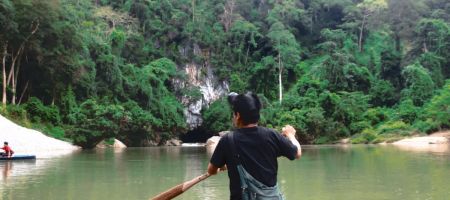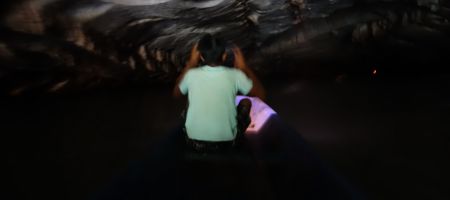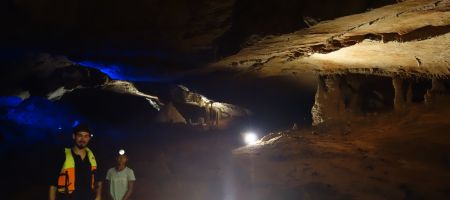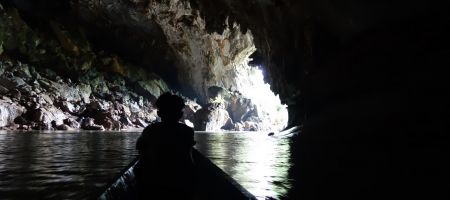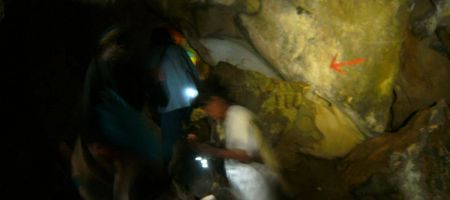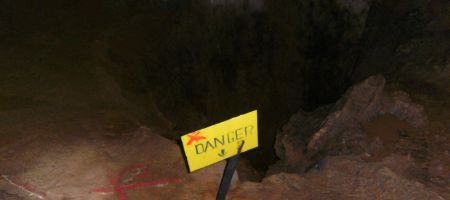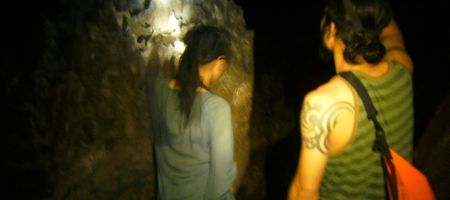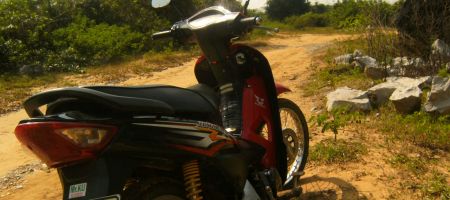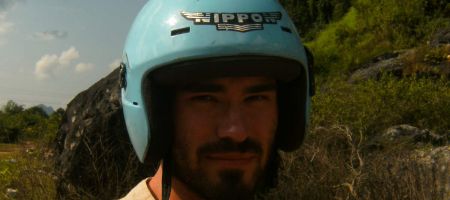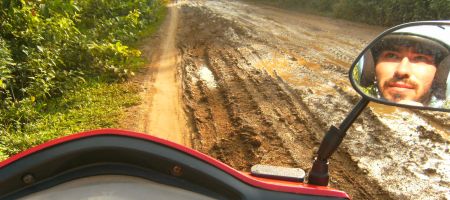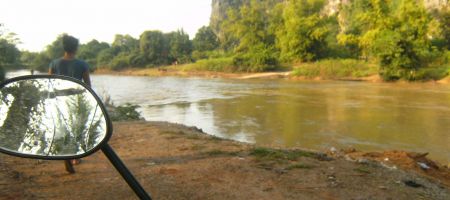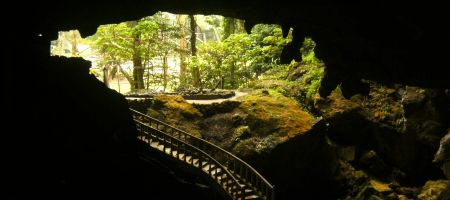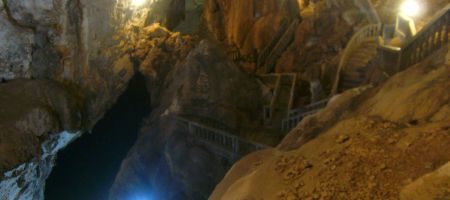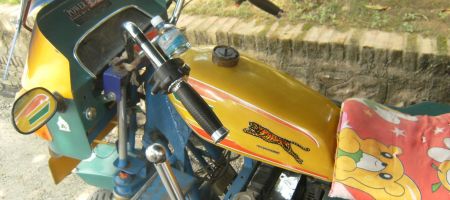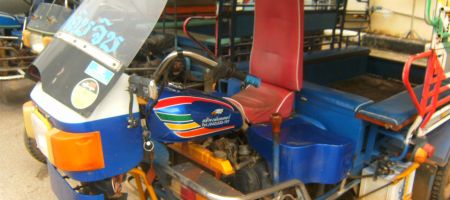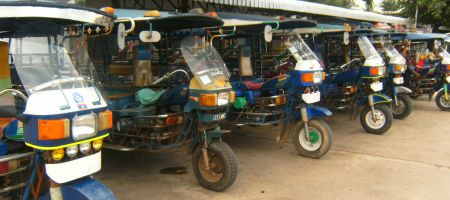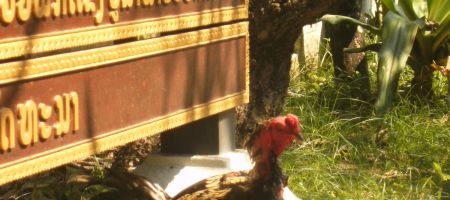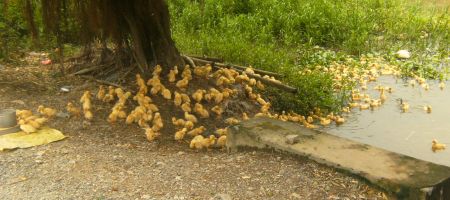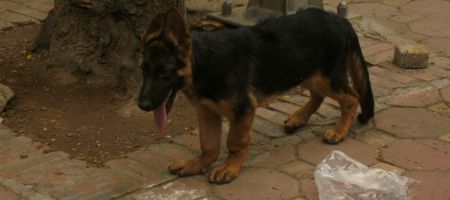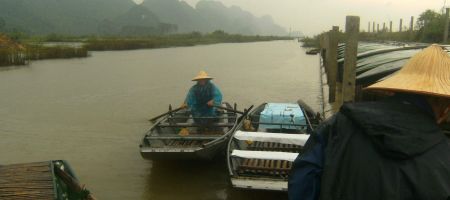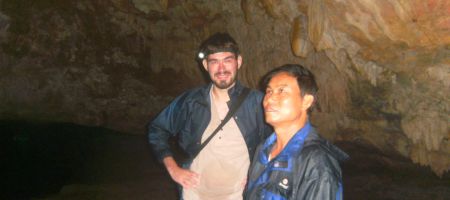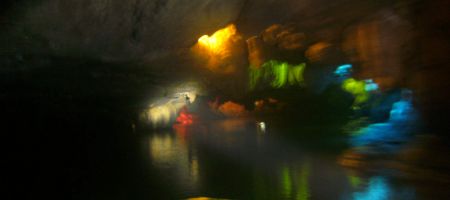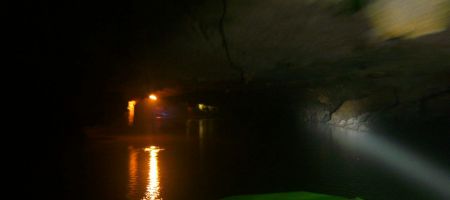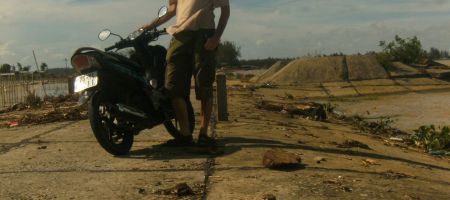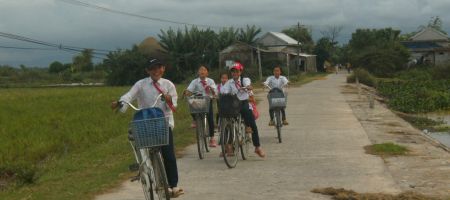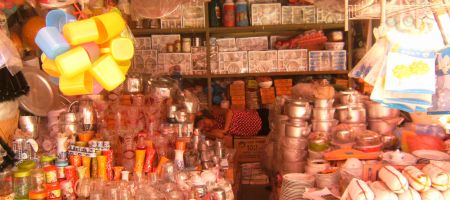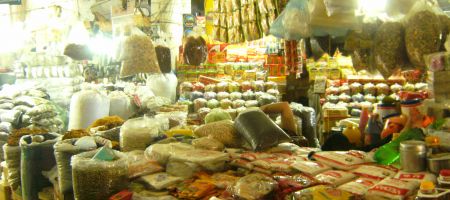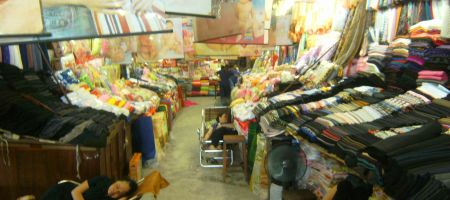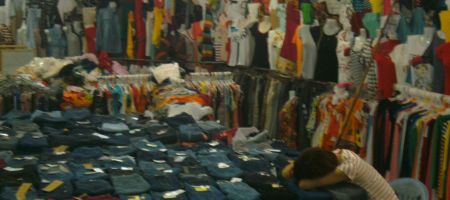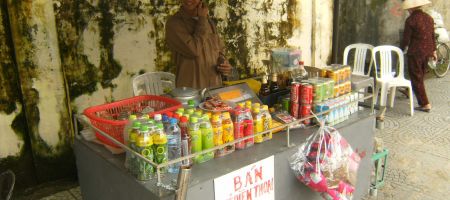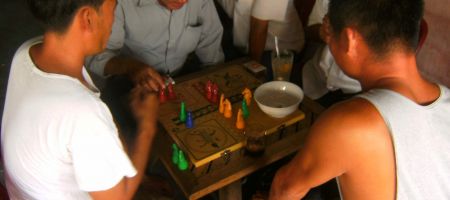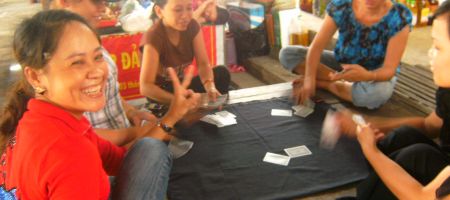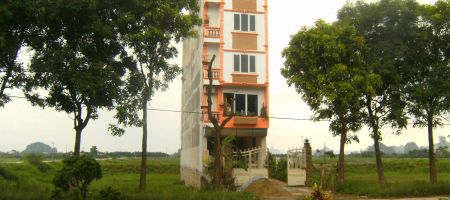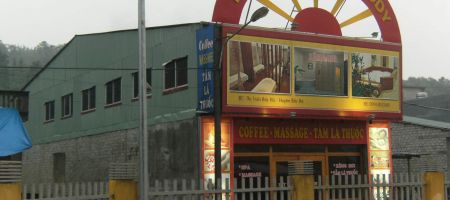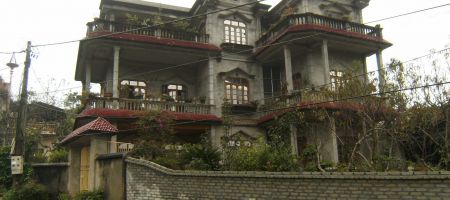Spelunky
From Na Hin at route 8 about 40 km south there is Ban Cong Lor. Of the caves I have visited, Kong Lor Cave was the most impressing one. It is actually an underground river that connects Ban Kong Lor and Ban Natan each on different sides of a mountain range (see the map!). The cave is about 8 km long and it’s dimensions are breathtaking. Dimensions of which I thought before would only exist in movies; It really boost your imagination.
While going into the mouth of the cave, I fantasized about the cave being a giant ancient (petrified) monster. Later deeper in the cave, it was easy to imagine whole settlements alongside the riverbank, like the dwarves’ caves of the Lord of the Rings movies. To quote the Lonely Planet, often the ceiling really is church-high.
What puzzles me though is that at one point I saw a trunk of a tree stuck in the ceiling in a height of about 5-10 metres. How did it get there? It seems unrealistic that the river can rise to that height, given that I already visited the cave in the (end of) rain season.
In the same valley, we also just walked around near the village one afternoon and stumbled upon another (small, “normal-sized”) cave that we wanted to explore after fetching our headlights from the guesthouse. Though, after 50 metres into the cave or so and one flipflop lost later, we gave up. It was just too muddy, slippery and tight. According to the neighbour, it is called Porcupine Cave (translated) and there ought to be an exit some 100 metres from the entrance.
Deservedly but sadly as it will transform this tranquil and authentic village somewhat, the development of this cave will bring Ban Kong Lor a tourist boom in the short future. A paved road has been finished to the village a few years ago(?) and now there is even a direct tourist bus from Vientaine.
Otherwise, it’s surrounding landscape with it’s rice fields in the flatland and steep mountains surrounding the valleys is somewhat similar to that near Vang Vieng, which is also famous for it’s many caves (amongst other things)
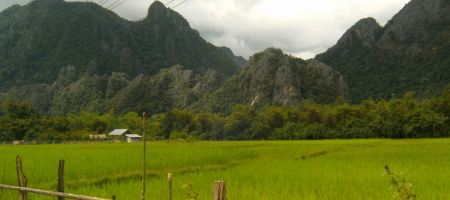
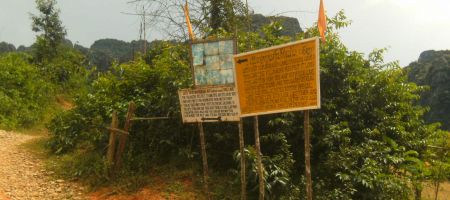
These pictures are from Vang Vieng
One particularly interesting cave near Vang Vieng one is Tham Phu Kam. With Kong Lor Cave mentioned in the same article, it is hard to use superlatives, but… well, every cave is unique. And even though it might not be, this cave feels quite untouched: Except for a few painted red arrows and one “Danger” sign in front of a bottomless pit inmidst the cave (not so much as a rail), there is nothing that guides one through there.
One is on his own and for a cave as big as this, it is a exciting experience to explore it.
Danger sign and the pit. I didn’t find a pebble.
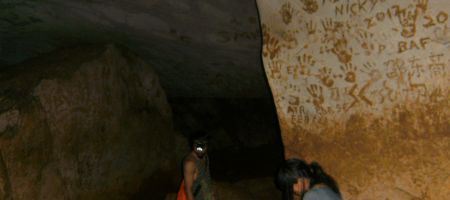
Spelunker graffiti in/below the second cavern written in mud. Let me make a hypothesis here: §1 – In every graffitied place, there exists at least one penis.
The way in this cave is quite unclear. The cave is to a certain extent 3D and there seem to be several caverns branching off in different directions, not sure though and not sure if they’d be big enough for a human. The main way continues over several (three) “Kong Lor-huge” caverns into absolute darkness, meeting an underground stream further down. It looked like it would be possible to go even further into the cave by following the underground stream but we’d have had to cross the muddy stream first and we were too afraid to do that in our flipflops and no gear except headlights.
Also, did you know that the eyes of big cave spiders reflect light like tiny little reflectors? The reflection can be mistaken as a drop of water. Stuff that suddenly jumps from you won’t be spiders though but some kind of cave crickets.
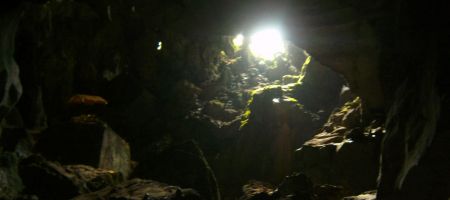
Out again. The first cavern receives sunlight from a hole in the ceiling. (The gold roof to the left contains a roughly human-sized reclining Buddha).
Comment [1]

Muddy Roads
Being a geographically big but scarcely populated and otherwise quite agrarian country, Laos has not much to offer for the sightseeing tourist.
The few towns there are, are all in the relative lowland, glued to the riverbank of the Mekong river which for the major part forms the boundary between Thailand and Laos. The town centres are all surprisingly compact.
The rest of the country is mostly mountains, jungle or both.
So apart from taking in the relaxed city centres in their colonial atmosphere, what makes Laos appealing to visit is it’s vast untouched nature, and in terms of sights, natural wonders like waterfalls, caves and the like.
And so the most impressive caves I have seen so far have all been in Laos.
Getting there is part of the adventure as (local) public transportation is somewhat scarce or inaccessible. For most caves, an own vehicle is essential.
Whenever I rented a motorbike in Laos, it was always the above model, a 4-geared Chinese-made clone of the popular and reliable Honda Wave that apparently only costs half of what the Honda costs. Well, I actually can’t say anything about the reliability of the Wave but it can be only more reliable than the Zongshen version: Each time I rented this model I found out that something was not working right. One time it was the light, clutch (just needed more force to change) and speedometer1, another time it was the fuel tank display and the rear break (wouldn’t loosen after braking). But I am not complaining, for thirty to fifty thousand kip a day (3-5€) I don’t expect they rent out anything better maintained than what normally goes on the streets in Laos.
By the way: Honda Wave and the like are not scooters. The most important differences being that they have gears (semi-automatic), that you sit on it like on a motorbike (left foot changes gears, right foot is the rear brake) and that they have better suspension with proper sized wheels which makes them eligible for the countryside. This motorbike design seems to be utterly unknown in Germany, closest relatives are the mopeds or mokicks, while on the other hand, the standard motorbike design we know is quite rare here.
So, there are a couple of caves near Tha Khaek, though I had to learn that most are not accessible during rain season (end of September). Well, at least not with a motorbike – perhaps with a 4WD.
Except for the most important national “highways”2, most of the roads in Laos are dirt tracks or compacted roads. Needless to say they can become so muddy during rain season that they are rendered unusable for anything more civilian than Landrovers and the like.
For half an hour or so I had to go through this section of an otherwise good compacted road en route to “Buddha Cave”. (It feels as if half of the caves in Laos do have this name.)
Another obstacle are rivers. Just 50 metres in front of where I took this photo, a sign said “Elephant cave this way, 300m”. Most (all?) fords are not accessible during rain season. (Also, it feels like the other half does have this name ;-))
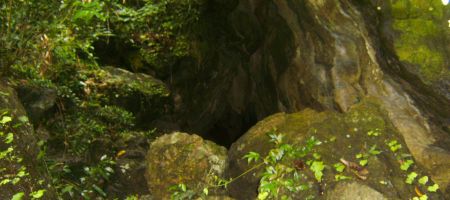
Speaking of rivers: I couldn’t get into this cave because the water flowing out of this cave was too high.
Finally at a cave that I could access, a view to the entrance. This kinda reminds me of a particular loader screen for Clonk Rage.
This cave is quite developed, but that’s okay. There are enough others that are left untouched and for this cave, it really adds to the atmosphere. Below is an underground river, but the tide was too high to get to the boats. Rain season.
Stay tuned for the second part of this article!
1 Not implying that 90% of all speedometers in Laos are not broken anyway.
2 Even though they call it highway, for me, a non-segregated road that has only one lane in each direction with foodstalls, pedestrians and bicycles occupying the sides of it does not qualify as a highway.

The Skylab
There are almost no classical Tuk Tuks in Laos. Looking at state of the roads in Laos, it is no wonder why. Except for the main roads, most roads are unpaved, rocky tracks.
With those tiny wheels and bad suspension, they would break pretty quickly.
So, instead, there is the Skylab!1
It looks like a massive motorbike with broad all-terrain tires (depending on the area) and the latter part of that bike replaced with a colourful wagon with two tiny benches left and right, pretty much like a “song thaew”.
Of course, no Skylab is complete without adding lotsa colourful lights, shiny stickers and the most important thing: A hammock in the wagon-area to relax while waiting for customers. Just for the latter, it is so much cooler than a standard Tuk Tuk! :-)
1 No, I have no idea why it is called that way. Sometimes they are called Jumbos as well, that nickname is more comprehensible. It can transport up to 6 people instead of 2.
Comment [1]

Welcome to Laos
You know you are in Laos when you see…
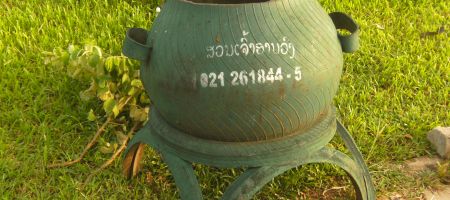
Laotian public garbage bins made from old tires.
…and…
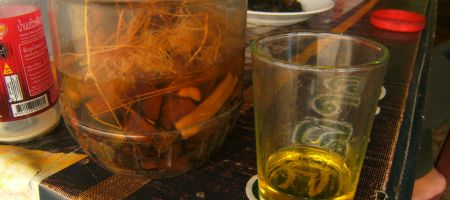
The (in)famous Lao Lao, homemade liquour. In the back: Fried bats.
Both were offered to me when I made a stop during a motorbike ride through the countryside. I only tried the former ;-)

Langer Lulatsch Kleiner Dotz
It is interesting to see the little differences in the breeds of livestock and pets that are prevalent here.
Many cats have just a stub of a tail. Otherwise they are pretty much the same as European cats, only that most are smaller and more shy. But those may very well be young cats (stray cats don’t live that long and reproduce faster).
Chickens sport much longer legs and generally look more dangerous than the meaty European version. Though I think there are two main breeds here, one more chubby and one more chicken-fighty version cause the latter really acts more aggressive (yes, they also do it here).
By the way, if not currently “busy” being sold at the market or being slaughtered, most do run around in village (and town) freely. Just like all the other animals actually: stray cats, dogs, ducks, goose, cows, water buffaloes etc.
Especially in villages, there are loads of ducks, most of which I saw in Vietnam.
The regional differences in South East Asia are also interesting. On the topic of street dogs, I got the impression that there are much bigger ones in Laos than in Thailand (~no street dogs in Vietnam, they eat them). Also, more are black in colour rather than ochre and like in Vietnam, more dogs have ridiculously short legs. Look at this one:
Comment if you did get the reference from the title ;-)
Comment [1]

Galaxy Grotto
In Nimh Binh in Vietnam, I heard about that there is quite an impressive cave 25km from the city. This was a great opportunity to try out a new flashlight I bought. Since the cave wasn’t mentioned in my travel guide or any map I had, it turned out to be more difficult than imagined to get there. Mainly because I completely underestimated the distance to the cave:
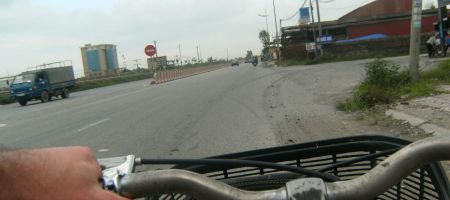
On the first day, I attempted to go there by bicycle after I visited a few other spots that I only found out about by looking at my offline-version of the openstreetmap.
To reach there, I had to go about 15 kilometres on national highway 1A (and then another 10 km to the cave) with the bicycle, which was quite stressful as the highway is quite busy with trucks and one has to evade pedestrians and other motos and bikes coming from the opposite direction (but driving on the wrong side of the highway) all the time.
It took so much time that on reaching Tam Diep, I decided to give up because I calculated that I will never reach the cave and come back from the cave before dark. Urk, so 15km back on the highway. It was the right decision though because as it turned out the cave is even further away than I thought and also one cannot just go in there by oneself but has to get a guide and a boat from the ferry boat station. Something that wouldn’t have been available at 8 o’clock in the night.
So, on the second day, I got a mototaxi to take me there and back. Since I chartered the ferry and guide (I was the only one there) that took me through the cave, it was okay that I took the mototaxi driver with me :-).
The first cave, the Galaxy Grotto, was well lit (in the sense that it looked nice, not that it was bright) which made the photos look halfway sharp but also dimmed the effect of the flashlight on the photo.
By the time we entered the second cave (Buddha cave), which was not lighted, the inner lens of my camera was so fogged from the humidity in the previous cave that I couldn’t make proper photos anymore. Given the quality of my snapshot-camera and the fact that we were on a moving boat, I probably couldn’t have anyway.
And, I mapped it! As most other things I encounter during my travels actually but anyhow.
In case you don’t know about it yet, there have been added two improvements on openstreetmap.org which make it much easier to contribute to the map recently:
- There is an easy-to-use HTML5 in-browser editor for openstreetmap now called iD.
- Without registering, it is possible to add notes to the map (e.g. “this road is a oneway street south”, “the bridge is called XYZ”), much like the discussion tab in the Wikipedia
It is only a matter of time now until you can add these notes to the map using popular apps for your smartphone.

Bonsai trees
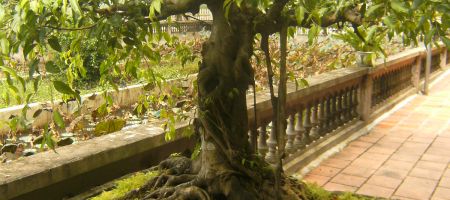
Bonsai tree near Tam Coc. Love it, can I have one for home? They are a popular decoration at temples and monasteries as well.

How to extend your stay in Vietnam
Easy.
Rent, or even buy a motorbike!
The time you spend in Vietnam will seem so much longer – and more worthwile.
I actually met a German in Hoi An who bought a Honda Minsk (he paid 250$) for his one-month stay in Vietnam.
One day before leaving Vietnam, I decided to rent a motorbike to explore Hue and vicinity. Riding a motorbike and thus not being dependent on other people for transportation is already a worthwile experience in its own right. But also, on this day I experienced so many genuine things way away from the “tourist attractions” that I will certainly remember this day until the end of my life.
Driving in cities is challenging at least (gosh, do they ever stay on their side of the road?), but I could always go slower then and most of the trip I drove around rural areas and villages.
Also, already few kilometers from the traveller hotspots is enough distance to avoid most of the hassle one is normally confronted with in Vietnam. It was lovely to meet Vietnamese that had so little interest in getting money out of me but instead showed hospitality and treated me like a normal person. :-)
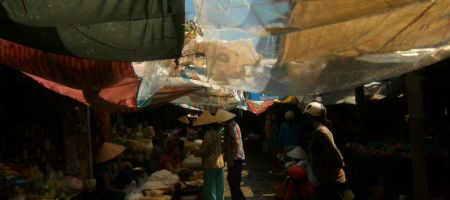
Market in some village near Hue. The canvas covers often hang so low that as an European one constantly has to duck while walking through such open-air markets.
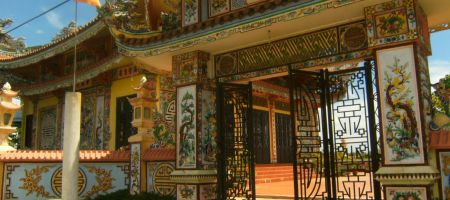
This is how the typical village temple (in Hue region) looks like. This temple is very new, chances are that the whole construction minus the ornaments are cast out of concrete.
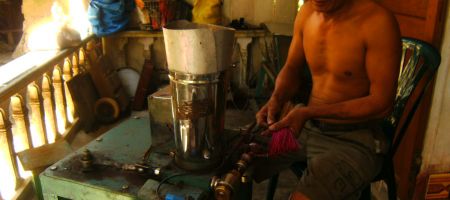
While admiring the temple, I was invited inside for a tea by the people there. They also had this machine for making incense sticks.
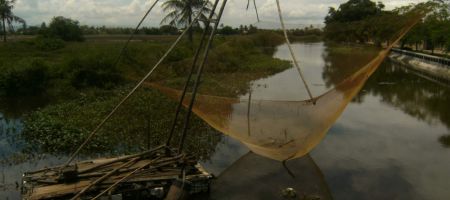
A common sight on the road: A fisher net. It is simply lowered into the river and after some time pulled out again, containing all the fishes that were swimming over the net at that time.
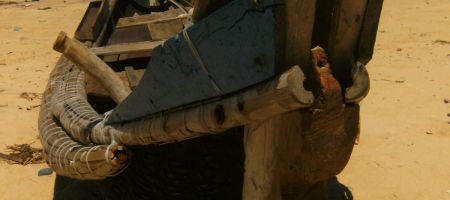
Fisher boat on the beach near Hue
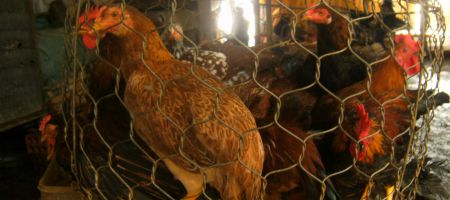
Chickens at the market. I might become a vegetarian after what I’ve seen in Vietnam…

Siesta
Every town in Vietnam will have a small market that is open every day with more or less fixed stalls in a roofed building. The market is the commercial heart of the town.
At noon until late afternoon however, the market goes to sleep. In Ninh Binh, I walked through the market at that time and saw this:
(So, how many did you count? ;-) )
Noon to late afternoon is the time sitting down at one of the plenty cafés or drink stalls, talking with your friends and colleagues and sometimes play games while being there.
A drink stall on wheels. Not on the picture are the tiny chairs and tables he pulled out of his trunk.
Apart from Vietnamese chess and cardgames, horse-themed Ludo (“Mensch ärgere dich nicht” in German) and Domino are played. All can be played for money.
Comment [3]

Architecture
Taking a break from those heavyweight posts with a lot of text to read, here is a typical modern family home in an unusual environment (at a rural road) :-)
Apparently, the land price is oriented on the width of the land along the road. So houses in general are very high and slim.
Also, for some reason, the Vietnamese only bother about the front of a building. Often, the sides of a building are left without windows and in concrete-grey without paint.
In the Lonely Planet, there are reports about that in Hanoi, a dubious guesthouse owner rebuilt the front of another actually recommended guesthouse to lure travellers into his. But only the front.
This “massage body” building does not do well in hiding that it was indeed a barn before it has been converted into a “first class” spa. (Just as a side note: From the inside, it indeed looks like on the photos)
There is still quite a bit French architecture left from the colonial era, most of which are in a somewhat crumbling state. Though, the French era influenced modern Vietnamese architecture. Any new representative buildings or expensive hotels will look somewhat French. Upper-class family homes will often look something like Neuschwanstein-Disneyland-French (we all know, Southeastasians love bright colors). This piece, found in Bac Ha and still under construction is still missing the colors which makes it look like a cool Geisterhaus:

